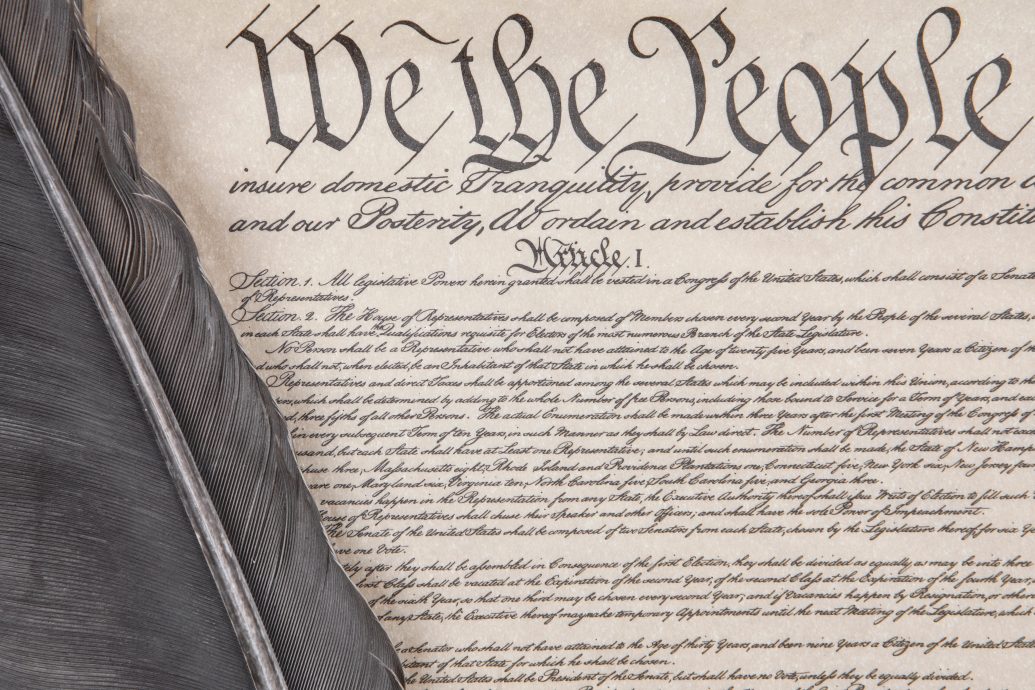The Legal Turn: McGinnis and Rappaport Respond to Their Critics
In this reply, we were almost inclined to declare victory and leave it at that. After all, the three commenters agree with our principal thesis that the Constitution is now often treated as a legal text. Even Ilan Wurman, who demurs from the full extent of the legal turn, concedes that looking at the Constitution’s text through the prism of law can make a difference and is sometimes appropriate. And, significantly, no one chose to contest our claim that this legal turn helps render the Constitution more accurately and precisely, dissolving ambiguities and tempering vagueness. Nor has anyone disputed our many examples of legal scholars who make use of the legal turn when interpreting the Constitution.
But all of the learned commenters raise interesting questions and deserve a more extended treatment. Ilya Shapiro emphatically agrees with our thesis that the Constitution should be treated pervasively as a legal text. He simply argues that everyone already agrees with that position. Would that this were so. But it is not the case historically or even presently. As we noted, Justice Antonin Scalia, the most famous modern originalist, more often than not claimed that the Constitution should be read in ordinary language. Larry Solum, one of the academy’s leading originalists, still argues that the Constitution should be read in ordinary language. To be sure, he concedes that the Constitution contains legal terms of art. But for Solum these are islands of legal meaning in a sea of ordinary meaning. That is a very different claim than believing that the Constitution’s text is pervasively legal. Indeed, Ilan Wurman takes much the same position as Solum in his comment on our essay. Shapiro’s claim thus does not hold even within the confines of this Liberty Forum.
Kevin Walsh unsurprisingly concentrates on this own thoughtful and innovative example of the legal turn, which we included as one of our primary examples. There is nothing wrong with that, but it should not obscure the more general truth, that whether the legal turn is thought to be predominantly expressed through natural law, the common law, or, as in our view, through legal interpretative rules deemed applicable at the time, it is law and legal methodology that is doing the work to bring the Constitution into clearer and sharper focus.
We spend most time on Ilan Wurman’s reply because he alone contests our view that the Constitution has a pervasively legal meaning. Moreover, unlike the other commenters, he focuses on our own theory of original methods originalism in his disagreement. His essential dispute with us is that he believes that the preferred public meaning is the ordinary meaning. Like Larry Solum, he recognizes that legal terms of art must be interpreted legally but rejects the notion that the Constitution has a pervasively legal meaning.
Our first disagreement with Wurman is the distinction he draws between public meaning and legal meaning. We do not believe this is the relevant distinction. While we agree with him that the Constitution should be interpreted according to its public meaning, the salient question is whether that public meaning is the legal meaning or the ordinary meaning. Our argument is that the Constitution is written in the language of the law and thus its public meaning is constituted within this language. After all, the language of the law is not the private or subjective meaning of an individual. It is instead the public meaning of a large group. Our new articulation of the nature of public meaning is part of the reason that the legal turn is a significant advance in originalist theory – comparable to that between the shift to original public meaning from original intent.
To be sure, we agree that some of the Constitution’s words are to be interpreted in their ordinary meaning. But that is the result of one of two unremarkable propositions about the language of the law. First, the language of the law, like any technical language, incorporates large elements of ordinary language. Second, when it is unclear whether a word should be given its ordinary or legal meaning, the language of the law contains rules to help the interpreter select which meaning . Although sometimes the result of those rules is to choose the ordinary meaning, the language of the law and its rules are the ultimate determiner of meaning.
The most important evidence for determining whether the public meaning of the Constitution is the language of the law or ordinary language is the language of the document in its entirety—something Wurman does not address. We have shown that there may be hundreds of terms in the Constitution that either are patently legal (such as Letters of Marque and Reprisal) or have at least a legal meaning in addition to their ordinary meaning (such as “confronted” in the Confrontation Clause). Moreover, the Constitution has clauses that are primarily used in legal documents, such as preambles, and other clauses whose meaning depends on recognizing their relation to interpretive rules, such as the Supremacy Clause. This large number of terms and references to legal rules support our view that the readers of the Constitution would be on notice of this language for interpretation. There is nothing unique about a Constitution in this respect. Most people on encountering an interpretative difficulty in a will or a contract would want to consult a lawyer to resolve it, even if they had their own opinion on its resolution.
Wurman’s leading effort to show that, despite our evidence, there was a preference for the ordinary meaning over the legal meaning as the public meaning is to rely on Blackstone, but he misconstrues that famous jurist. It is worth quoting the relevant passage in full to show that Blackstone was not, as Wurman suggests, contrasting ordinary and legal meaning with a preference for the ordinary, but contrasting accurate and literalist meaning with a preference for the accurate.
Blackstone writes:
Words are generally to be understood in their usual and most known signification; not so much regarding the propriety of grammar, as their general and popular use. Thus the law mentioned by Pufendorf, which forbade a layman to lay hands on a priest, was adjudged to extend to him, who had hurt a priest with a weapon. Again: terms of art, or technical terms, must be taken according to acceptation of the learned in each art, trade, and science. So in the act of settlement, where the crown of England is limited “to the princess Sophia, and the heirs of her body, being protestants,” it becomes necessary to call in the assistance of lawyers, ascertain the precise idea of the words “heirs of her body;” which in a legal sense comprise only certain of her lineal descendants.
The focus of the above paragraph is on discovering the “usual and most known signification” of words. Two examples are given. One is from ordinary language (“lay hands on a priest”) and the other from legal language (“the heirs of her body”). The common mistake Blackstone is warning against in both examples is following the literal meaning rather than that which is most known in the relevant community. That Blackstone is not contrasting ordinary language with legal language in order to prefer the former is made clear by the conjoining word, “Again,” between these examples. His second example, which involves technical meanings, is another example of using words in their “most known signification.” It would not be such an example if Blackstone meant by that language the signification with the widest following. Blackstone’s comments thus do not offer any presumption in favor of popular meaning. Instead, his emphasis on accuracy suggests that he would determine whether the public meaning of a document is legal or ordinary based on the overall context—an approach consistent with our own.
Nor is Wurman correct that James Madison supports a preference for ordinary meaning when he writes that the meaning of the Constitution “must be not sought in the opinions or intentions of the Body which planned and proposed the Constitution, but in the sense attached to it by the people in their respective State Conventions where it received all the authority which it possesses.”
Madison’s comment comes in the context of a discussion of publicizing his Notes on the Philadelphia Convention. Here he offers his view that the understanding of those at the state ratifying conventions rather than those at the Philadelphia Convention is crucial to fixing the meaning of the Constitution. Thus, his statement has nothing to do with the distinction between popular and legal meaning. This point is underscored by the reference to “the people” in the passage. It is not to the people in general but to those particular people at the ratifying conventions. Moreover, the ratifiers may not have been as much the elite as those at the Philadelphia Convention, but they surely could be expected to realize what we have shown: that the document was pervasively written in the language of the law. Indeed, in the ratification debates, participants relied on legal interpretive rules to determine the meaning they were disputing.
At the end of his essay, Wurman says that a popular understanding of the Constitution’s words is necessary to its legitimacy. This is a category mistake, confusing the meaning of the Constitution with its force. In any event, as we have argued in more detail elsewhere, the language of the law does not undermine its legitimacy. First, it was ratified by representatives many of whom were lawyers and conversant with the language of the law. Second, the Constitution does give even people without knowledge of the language of the law a general sense of its plan. Third, those who were not conversant in it could learn more about its meaning as it was explicated in the debates over ratification.
The power of our thesis has been further demonstrated by more evidence both in legal scholarship and the Supreme Court since we drafted our original Liberty Forum essay. Ryan C. Williams has written an article explicating the constitutional provision by which the United States “guarantees” each state a Republican form of government. By looking at the legal practice of 18th century treaties he shows that the term “guarantee” provided only quasi-diplomatic assurances for one nation to aid another. Williams suggests that this meaning casts doubt on interpreting the Guarantee Clause as a source of judicially enforceable rights. Note that the word “guarantee” does not appear, on its face, to be a term of art. It has a perfectly understandable meaning in ordinary English—a meaning which might well be more amenable to the implication of enforceable rights. Yet Williams resolves the issue by reference to international legal practice.
In his concurring opinion in Sessions v. Dimaya, issued last week, Justice Neil Gorsuch fixes the meaning of due process by looking to preexisting English law. Gorsuch argues that the Due Process Clause entitles people to the “customary procedures to which freemen were entitled by the old law of England.” And he finds that fair notice was something to which freemen were entitled and which courts enforced, thus justifying courts in refusing to enforce vague statutes. Gorsuch treats due process as part of the language of the law. The legal turns continues to gather strength.


